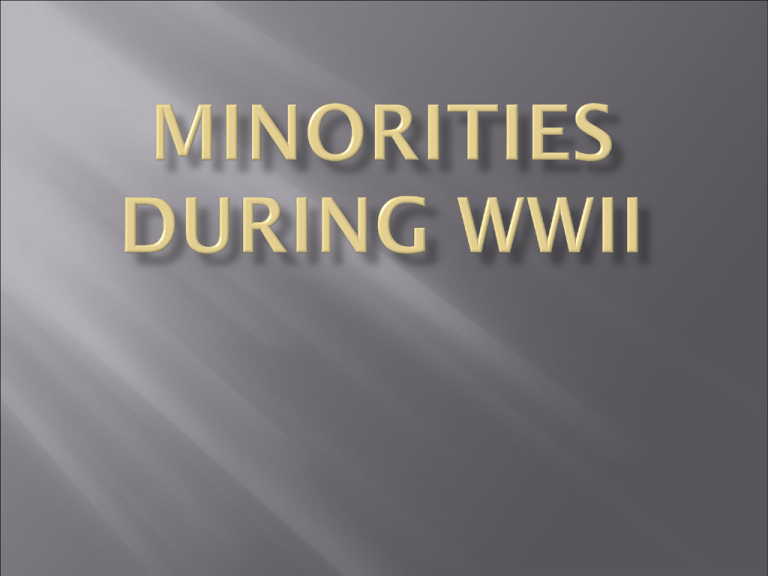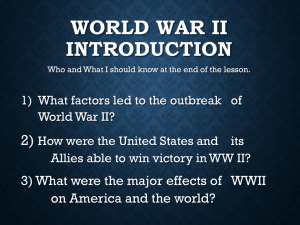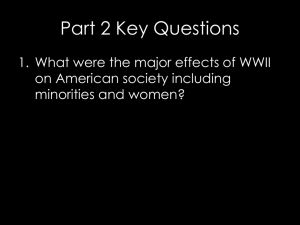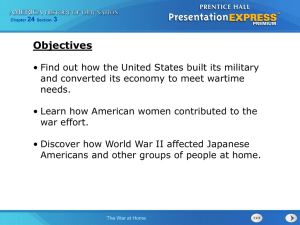Rosie the Riveter
advertisement

African Americans moved north in search of higher paying factory work. In some communities, they were unwelcome. Many worked in war industries and government agencies. African American soldiers played a significant role in WWII. 2.5 million registered for the draft. One million served African American leaders demanded and finally obtained permission to form all – black combat unit. The Tuskegee airmen were an African American fighter group in the Air Corps. Their main job was to provide escorts for pilots on bombing missions. Despite some gains, African Americans still continued to face prejudice at home. They had to serve in segregated units and faced prejudice in the Northern cities where they came to looking for jobs. There were race riots in Detroit (1943). There were 34 deaths during the riots. Roosevelt sent federal troops to stop the violence. http://www.youtube.com/watch?v=SfyJ1A7x MMc Japanese-American citizens get notified – report to relocation centers. War Relocation Center in Wyoming Many Japanese – Americans sold their businesses and property quickly at tremendous losses. President Roosevelt issued Executive Order 9066, which required all people of Japanese descent living on the West Coast to report to internment camps. Fred Korematsu challenged the order. Fred Korematsu changed his name and hid out for a while. Eventually he was caught. He challenged his internment stating that he was a lawabiding citizen and a loyal American. The Supreme Court heard the case and ruled 6 – 3 that the internment was justified due to circumstances of “emergency and peril.” - - Search by image Images may be subject to copyright.-Send feedback Try these too: - - Images may be subject to copyright.-Send feedback http://www.youtube.com/watch?v=6Mc0UW pRRF4 For many women in America, WWII brought not only sacrifices but also new jobs, new skills and new opportunities. Women could not enlist in the regular army but they joined the new Women’s Army Corps, or WACS in large numbers. After basic training, most of these women took clerical jobs in the military. In civilian life, many women replaced jobs formerly held by men. Rosie the Riveter--the strong, competent woman dressed in overalls and bandanna--was introduced as a symbol of patriotic womanhood. The implements of war work--uniforms, tools, and lunch pails--were incorporated into the revised image of the feminine ideal. http://www.youtube.com/watch?v=9 CQ0M0wx00s More than 300,000 Mexican Americans served in the military and 17 earned the Congressional Medal of Honor. Many Mexican Americans moved from the Southwest to industrial centers in the Midwest and on the West Coast. Under the 1942 agreement between the United States and Mexico, thousands of Mexican farm and railroad workers known as braceros came north to work in the Southwest during the WWII. The Los Angeles press was hostile to zoot suiters, many of them Mexican American young people. The newspapers depicted them as hoodlums. With the nation at war, headlines about zoot suiters shared column space with articles on Allied advances in Europe, food shortages at home, and advertisements urging American victory. http://www.youtube.com/watch?v=mEmLceMg v7s Native Americans enlisted for military service in higher proportions than any other minority group. More than 25,000 served in combat during the war. Nearly 40,000 Native American men and women left their reservations for the first time to work in defense industries. Navajo Code Talkers were a group of Navajo Marines who came up with the code the Japanese could not break. http://www.youtube.com/watch?v=5rSvm3m 8ZUA Using the information you have just learned, 1. Using a Venn diagram compare and contrast two minority groups of your choice. 2. Read over the notes you took today. Decide which minority groups benefited and which ones lost as a result of the war. Cite specific facts to back up your conclusions. 3. Explain how either Tuskegee Airmen or the Navajo Code Talkers distinguished themselves in combat and contributed to war effort




